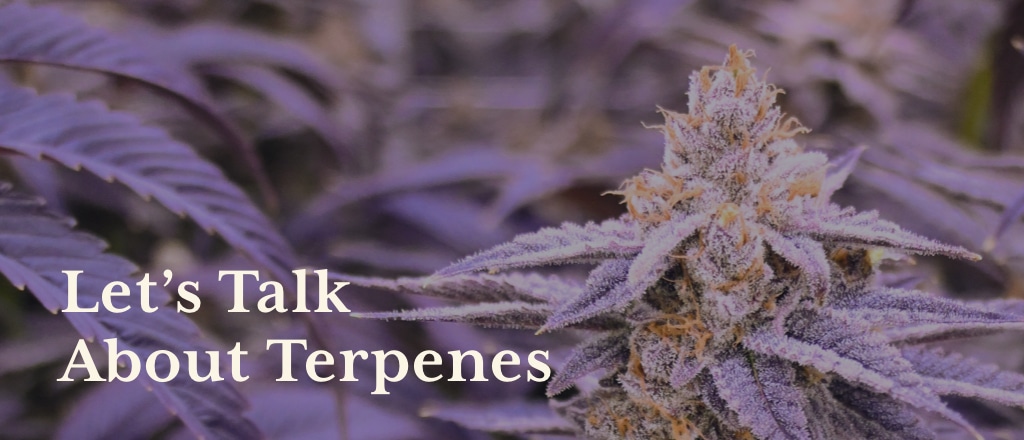
When it comes to weed, most people tend to have a preference between indica, sativa, and hybrid strains. Or rather, many cannabis connoisseurs at least have a preference of what types of bud they prefer in specific situations. What is often left out of these categorizations is the complex impact that compounds such as terpenes can have on how you experience cannabis. Read on for a crash course in cannabis chemistry.
Terpenes, sometimes referred to as terpenoids or terps, are naturally occurring chemical compounds found in many different types of plants as well as some animals. They are often responsible for the distinctive aromas, flavors, and colors associated with different types of vegetation. In plants, terpenes serve all kinds of helpful purposes, attracting pollinators, warding off predators and infection, and aiding in recovery.
Isolated terpenes are often used to add flavor and aroma to products such as perfumes, cleaning solutions, and even food. In the context of cannabis, terpenes are what give different strains their distinctive scent and flavor notes, and can even be a better indicator of how a certain strain will make you feel than THC content is. We’ve spoken before about the Entourage Effect: when terpenes and cannabinoids interact synergistically in the human body to temper or enhance each other’s therapeutic effects.
When consumed by humans in the context of cannabis, terpenes can not only affect your high, but can even have some of the same effects on people as they have on plants, fighting off pathogens and assisting in healing. While hundreds of terpenes have been found in cannabis, only around a dozen are sufficiently present to have notable effects. Here’s the breakdown of some of the most common terpenes found in cannabis and what they do.
Myrcene
Myrcene has an earthy, herbaceous, musky aroma and a mildly sweet flavor profile. It is commonly found in hops, lemongrass, thyme, and mangoes. A powerful antioxidant, studies have found that it may help protect the brain from damage after a stroke when used in high concentrations. Myrcene may also prevent the breakdown of cartilage cells, meaning it has potential to treat osteoarthritis. It is anti-inflammatory, anti-fungal, anti-bacterial, and sedative.
Caryophyllene
Caryophyllene, which is sometimes classified as an atypical cannabinoid, is found in cloves, rosemary, oregano, and black pepper. Any weed that smells spicy, woody, or peppery is likely full of Caryophyllene. Caryophyllene is anti-microbial, anti-inflammatory, anti-viral, and neuro-protective meaning it has the potential to ease symptoms in conditions like colitis, diabetes, cerebral ischemia, anxiety, depression, liver fibrosis, Alzheimers, and more.
Limonene
Limonene is, you guessed it, lemony. Found in citrus peels and ginger, Limonene is fresh, citrusy, and sweet. It is known for its uplifting, mood elevating effects which can help to combat stress, anxiety, and depression. Studies show that Limonene also supports immune function. It is anti-inflammatory, anti-oxidant, anti-viral, and even anti-cancer, helping to inhibit the growth of cancer cells without affecting healthy cells. That’s quite the résumé! You’ll find Limonene in most cannabis strains that have a fruity aroma.
Pinene
Like Limonene, Pinene is just what it sounds like. This piney terp is naturally abundant and comes in two forms: A-Pinene and B-Pinene. It is responsible for the fresh, bright scent of many plants including pine needles, rosemary, and basil. Pinene acts as a bronchodilator allowing more air into the lungs, and may fight infectious germs when inhaled. It is also anti-inflammatory and helpful for alertness, memory retention, and pain relief.
Farnesene
Farnesene is another terpene commonly found in cannabis, although not typically in very large quantities. It is also found in turmeric, chamomile, green apples, sandalwood, and patchouli. It has a sweet, woody, herbal aroma with calming, sedative effects. Farnesene can act as a natural pest repellent, promote healthy digestion, fight bacteria that causes tooth decay, soothe your mood, relax your muscles, and even help to reduce oxidative stress in the brain.
